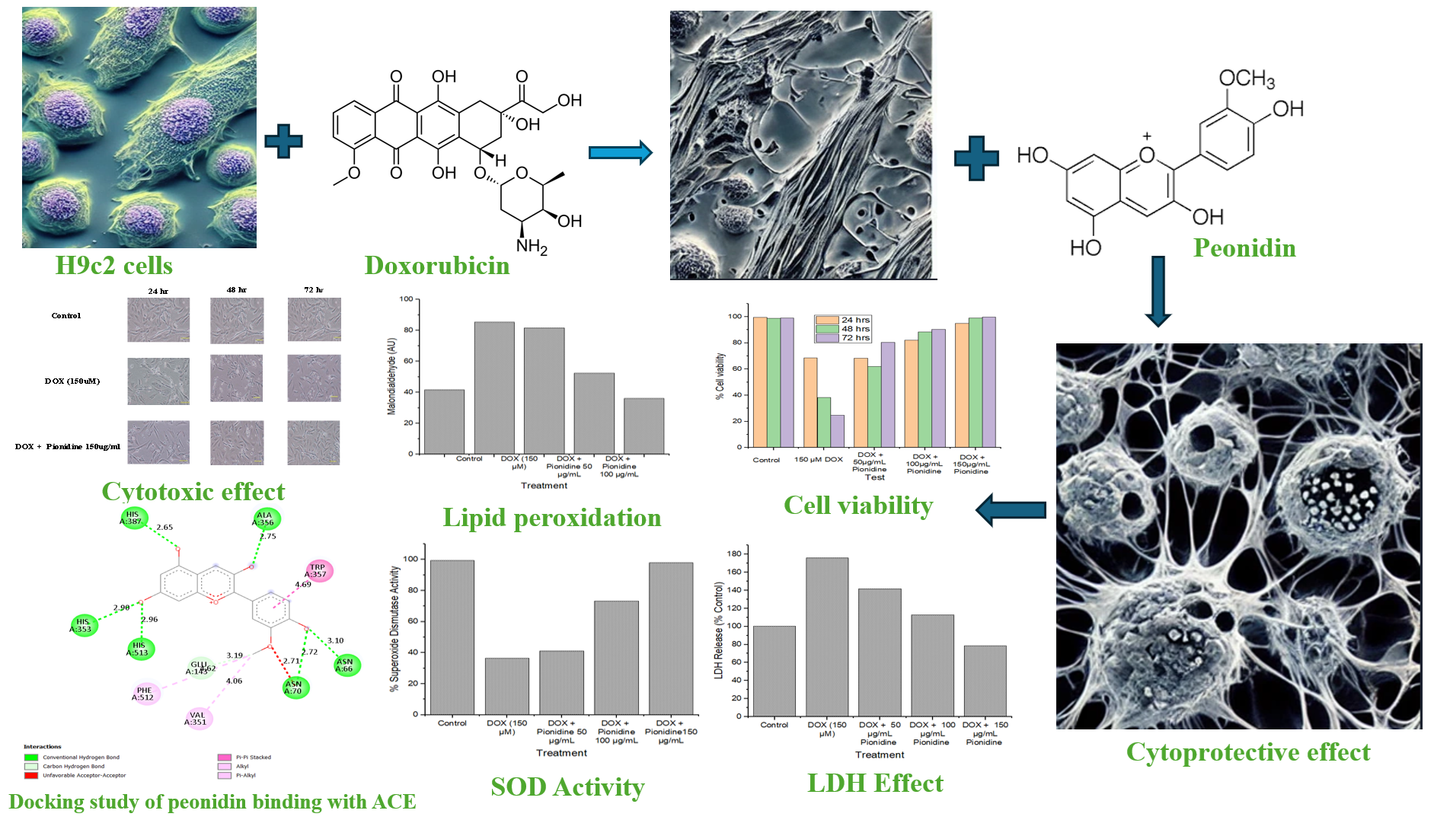Protective effect of peonidin - anthocyanidin class flavonoid against doxorubicin-induced toxicity in H9C2 cardiomyoblast cell lines
DOI:
https://doi.org/10.69857/joapr.v13i3.1024Keywords:
Peonidin, cardioprotective activity, H9c2 cardiomyocytes, docking studiesAbstract
Background: This study investigates the cardioprotective properties of peonidin against cytotoxicity induced by doxorubicin (DOX) in H9c2 cardiomyocytes using both in vitro and in silico methods. H9c2 cells were exposed to DOX alone as well as in combination with different concentrations of peonidin for various time durations. Methodology: Cytoprotection was studied using MTT assay for viability, LDH leakage, SOD activity, lipid peroxidation, and ROS content. Furthermore, molecular docking was also performed to analyze the binding affinity of peonidin with angiotensin-converting enzyme (ACE) and endothelin-converting enzyme-1 (ECE-1), utilizing captopril as a control. Results and Discussion: DOX drastically inhibited cell viability, whereas peonidin co-treatment maintained it dose dependently, restoring it to 99.74% at 150 µg/mL after 72 h. LDH release through DOX-triggered membrane disruption was alleviated from 175.84% to 78.40% by peonidin. ROS levels were also decreased from 191.13% (DOX) to 61.29% by peonidin, reflecting robust antioxidant activity. Lipid peroxidation was strongly inhibited, and SOD activity, decreased by DOX (36.59±0.306 AU), was restored close to control levels (97.85±0.313 AU) by peonidin. Docking studies indicated that peonidin exhibited a superior binding affinity with ACE (-95.72 kcal/mol) and ECE-1 (-78.08 kcal/mol) compared to captopril, characterized by good van der Waals and hydrogen bonding interactions. Conclusion: Peonidin potently mitigates DOX-induced oxidative injury in cardiomyocytes, showing great promise as a natural cardioprotective agent, as evidenced by both biochemical assays and molecular docking studies against ACE and ECE-1.
Downloads
References
Belger C, Abrahams C, Imamdin A, Lecour S. Doxorubicin-induced cardiotoxicity and risk factors. Int. J. Cardiol. Heart. Vasc., 50,101332 (2023). https://doi.org/10.1016/j.ijcha.2023.101332
Cardinale D, Colombo A, Bacchiani G, Tedeschi I, Meroni CA, Veglia F, Civelli M, Lamantia G, Colombo N, Curigliano G, Fiorentini C, Cipolla CM. Early detection of anthracycline cardiotoxicity and improvement with heart failure therapy. Circulation., 131(22), 1981-1988 (2015). https://doi.org/10.1161/CIRCULATIONAHA.114.013777
Pardo Sanz A, Zamorano JL. Cardiotoxicity time to define new targets? Eur. Heart. J., 41(18), 1730-1732 (2020). https://doi.org/10.1093/eurheartj/ehaa013
Saleh Y, Abdelkarim O, Herzallah K, Abela GS. Anthracycline-induced cardiotoxicity: mechanisms of action, incidence, risk factors, prevention, and treatment. Heart. Fail. Rev., 26 (5), 1159-1173 (2021). https://doi.org/10.1007/s10741-020-09968-2
Pongprot Y, Sittiwangkul R, Charoenkwan P, Silvilairat S. Use of cardiac markers for monitoring of doxorubixin-induced cardiotoxicity in children with cancer. J. Pediatr. Hematol. Oncol., 34 (8), 589-595 (2012). https://doi.org/10.1097/MPH.0b013e31826faf44
Laudani S, Godos J, Di Domenico FM, Barbagallo I, Randazzo CL, Leggio GM, Galvano F, Grosso G. Anthocyanin Effects on Vascular and Endothelial Health: Evidence from Clinical Trials and Role of Gut Microbiota Metabolites. Antioxidants (Basel)., 12 (9), 1773 (2023).
Routray W, Orsat V. Blueberries and their anthocyanins: factors affecting biosynthesis and properties. Compr. Rev. Food Sci. Food Saf., 10 (6), 303-320 (2011).
Namathoti J, Rajeshwari P. Cardio Protective Activity of Calophyllolide on Doxorubicin Induced Myocardial Damage. Toxicol. Int., 31 (4), 629–640 (2024). https://doi.org/10.18311/ti/2024/v31i4/42026
Ashutosh Bahuguna, Imran Khan, Vivek K. Bajpai, Sun Chul Kang. MTT assay to evaluate the cytotoxic potential of a drug. Bangladesh. J Pharmacol., 12, 115-118 (2017). https://doi.org/10.3329/bjp.v12i2.30892
Priti Kumar, Arvindhan Nagarajan, Pradeep D Uchil. Analysis of Cell Viability by the Lactate Dehydrogenase Assay. Cold. Spring. Harb. Protoc., 2018 (6), (2018). https://doi.org/10.1101/pdb.prot095497.
Murphy MP, Bayir H, Belousov V. et al. Guidelines for measuring reactive oxygen species and oxidative damage in cells and in vivo. Nat. Metab., 4 (6), 651–662 (2022). https://doi.org/10.1038/s42255-022-00591-z
Ayala A, Muñoz MF, Argüelles S. Lipid peroxidation: production, metabolism, and signaling mechanisms of malondialdehyde and 4-hydroxy-2-nonenal. Oxid. Med. Cell. Longev., 360438 (2014). https://doi.org/10.1155/2014/360438.
Weydert CJ, Cullen JJ. Measurement of superoxide dismutase, catalase and glutathione peroxidase in cultured cells and tissue. Nat. Protoc., 5 (1), 51-66 (2009). https://doi.org/10.1038/nprot.2009.197
Muhammad Tahir Aqeel, Nisar-ur Rahman, Arif-ullah Khan, Muhammad Tariq Khan, Zaman Ashraf, Syed Shams ul Hassan, Simona Gabriela Bungau, Muhammad Majid. Cardioprotective effect of 2-methoxy phenol derivatives against oxidative stress-induced vascular complications: An integrated in vitro, in silico, and in vivo investigation. Biomed. Pharmacother., 165, 115240 (2023). https://doi.org/10.1016/j.biopha.2023.115240

Published
How to Cite
Issue
Section
Copyright (c) 2025 Jyothirmai Namathoti, Rajeshwari Pasupula

This work is licensed under a Creative Commons Attribution-NonCommercial 4.0 International License.
















